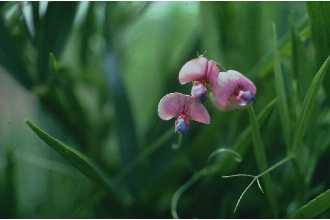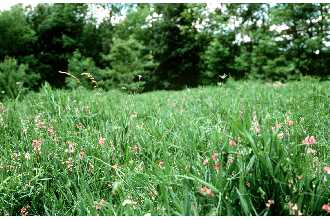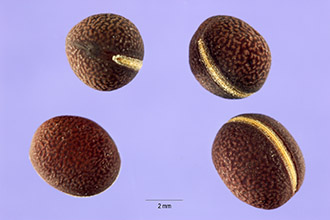Flat Pea
Scientific Name: Lathyrus sylvestris L.

| General Information | |
|---|---|
| Usda Symbol | LASY |
| Group | Dicot |
| Life Cycle | Perennial |
| Growth Habits | Forb/herbVine, |
| Native Locations | LASY |
Plant Guide
Use a soil moisture meter to monitor the soil moisture where Flat Pea is planted.
Fact Sheet
Uses
Flatpea is a long-lived erosion control plant that can grow on severely disturbed soil under acid conditions and begin a soil improvement process. It requires little input once established. Flatpea will inhibit the ability of other plants to invade the stand after it acheives full cover, and can be used to control woody plant encroachment of utility rights-of-way. Flatpea has also received extensive interest as a forage due to the high protein content, however the presence of high concentrations of diaminobutyric acid (DABA) has rendered this use unlikely. DABA is toxic to non-ruminent livestock, and also to ruminants if fed in quantity before the rumen is acclimated to it. Birds will utilize the seed and are not affected by DABA.
Status
Please consult the PLANTS Web site and your State Department of Natural Resources for this plant’s current status (e.g. threatened or endangered species, state noxious status, and wetland indicator values).
Weediness
This plant may become weedy or invasive in some regions or habitats and may displace desirable vegetation if not properly managed, Please consult with your local NRCS Field Office, Cooperative Extension Service office, or state natural resource or agriculture department regarding its status and use, Use soil moisture sensors to measure the soil moisture of Flat Pea., Weed information is also available from the PLANTS Web site at plants,usda,gov,
Description
Flatpea climbs through the use of tendrils and can attain heights of 5-7 feet if support is available. When no support is nearby, the plant has a height of 18-30 inches. In either case, a well-established stand forms a dense mat of vegetation. The stems and petioles are winged with leaf-like appendages. The leaf consists of two long, narrow leaflets with parallel veins and bears the tendril from juncture of the leaflets. The flowers are deep pink, and produce 2-inch long seed pods that contain the hard round seed. Both the seed and the pod are black or dark gray at maturity. Flatpea closely resembles sweetpea and perennial pea. USDA NRCS National Plant Materials Center Beltsville, MD
Adaptation and Distribution
Distribution
Distribution
Flatpea is adapted throughout the Northeast to soils that are moderately well drained or drier. It may also grow well on some sloping soils that are somewhat poorly drained. It is drought tolerant once established, and will grow on soils with a fines content as low as 15 percent (passing a 200 mesh seive). Low fertility and acid soils can successfully grow flatpea, and it will tolerate moderate shade better than will crownvetch. Flatpea is distributed primarily in the northwest and scattered throughout the eastern United States. For a current distribution map, please consult the Plant Profile page for this species on the PLANTS Website.
Establishment
Flatpea will not establish successfully unless the seed is incorporated into the soil. Broadcast and hydroseeding will not work unless subsequent erosion covers the seed, or a heavy mulch is applied. The best way to incorporate flatpea seed on disturbed sites is to track it in with a bulldozer. Inoculated flatpea seed must be spring planted, or dormant planted in mid-fall. A drill can also used to plant the seed 1-1 1/2 inches deep. Flatpea is always planted with a grass companion (typically tall fescue) to provide quick cover during the 2-3 year establishment period. With good agronomics on a good site, flatpea will cover the soil in 2 years. With poor methodology it may never be successful. Lime is needed if the soil is below a pH of 5.0, and moderate levels of phosphorus and potash are beneficial. Coat the seed with the specific inoculant immediately prior to planting. Plant flatpea at 20 pounds per acre with 15 pounds of tall fescue. More seed will not make up for lack of incorporation as outlined above.
Management
None is required. Mow the stand no more than once per year, after full bloom, and no sooner than the third year after planting. Cultivars, Improved, and Selected Materials (and area of origin) ‘Lathco’ (western WA) is the only cultivar, and is available in the seed trade.
Plant Traits
Growth Requirements
| Temperature, Minimum (°F) | -38 |
|---|---|
| Adapted to Coarse Textured Soils | Yes |
| Adapted to Fine Textured Soils | Yes |
| Adapted to Medium Textured Soils | Yes |
| Anaerobic Tolerance | None |
| CaCO3 Tolerance | High |
| Cold Stratification Required | No |
| Drought Tolerance | High |
| Fertility Requirement | Low |
| Fire Tolerance | High |
| Frost Free Days, Minimum | 140 |
| Hedge Tolerance | None |
| Moisture Use | Low |
| pH, Maximum | 7.8 |
| pH, Minimum | 5.0 |
| Precipitation, Maximum | 55 |
| Precipitation, Minimum | 30 |
| Root Depth, Minimum (inches) | 12 |
| Salinity Tolerance | None |
| Shade Tolerance | Tolerant |
Morphology/Physiology
| After Harvest Regrowth Rate | Slow |
|---|---|
| Toxicity | Moderate |
| Shape and Orientation | Decumbent |
| Nitrogen Fixation | High |
| Resprout Ability | No |
| Active Growth Period | Spring and Summer |
| Bloat | None |
| C:N Ratio | Low |
| Coppice Potential | No |
| Fall Conspicuous | No |
| Fire Resistant | No |
| Flower Color | Purple |
| Flower Conspicuous | Yes |
| Foliage Color | Green |
| Foliage Porosity Summer | Dense |
| Foliage Texture | Medium |
| Low Growing Grass | No |
| Lifespan | Long |
| Leaf Retention | No |
| Known Allelopath | No |
| Height, Mature (feet) | 2.2 |
| Growth Rate | Moderate |
| Growth Form | Rhizomatous |
| Fruit/Seed Conspicuous | No |
| Fruit/Seed Color | Black |
| Foliage Porosity Winter | Porous |
Reproduction
| Vegetative Spread Rate | Moderate |
|---|---|
| Small Grain | No |
| Seedling Vigor | Low |
| Seed Spread Rate | Slow |
| Seed per Pound | 8000 |
| Fruit/Seed Persistence | No |
| Propagated by Tubers | No |
| Propagated by Sprigs | No |
| Propagated by Sod | No |
| Propagated by Seed | Yes |
| Propagated by Corm | No |
| Propagated by Container | No |
| Propagated by Bulb | No |
| Propagated by Bare Root | No |
| Fruit/Seed Period End | Summer |
| Fruit/Seed Period Begin | Summer |
| Fruit/Seed Abundance | Medium |
| Commercial Availability | Routinely Available |
| Bloom Period | Early Summer |
| Propagated by Cuttings | No |
Suitability/Use
| Veneer Product | No |
|---|---|
| Pulpwood Product | No |
| Protein Potential | High |
| Post Product | No |
| Palatable Human | No |
| Palatable Graze Animal | Medium |
| Palatable Browse Animal | High |
| Nursery Stock Product | No |
| Naval Store Product | No |
| Lumber Product | No |
| Fodder Product | Yes |
| Christmas Tree Product | No |
| Berry/Nut/Seed Product | No |


